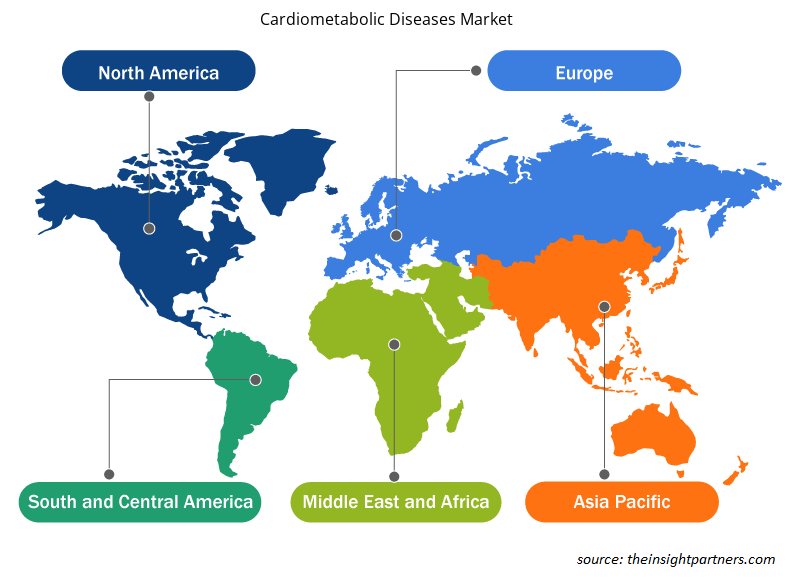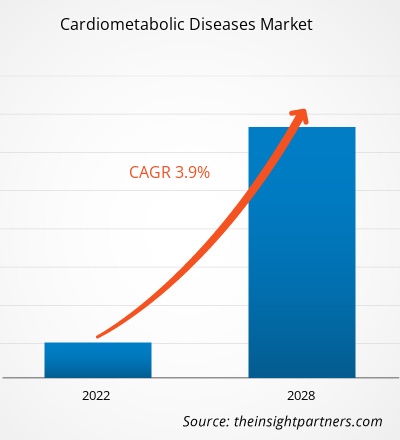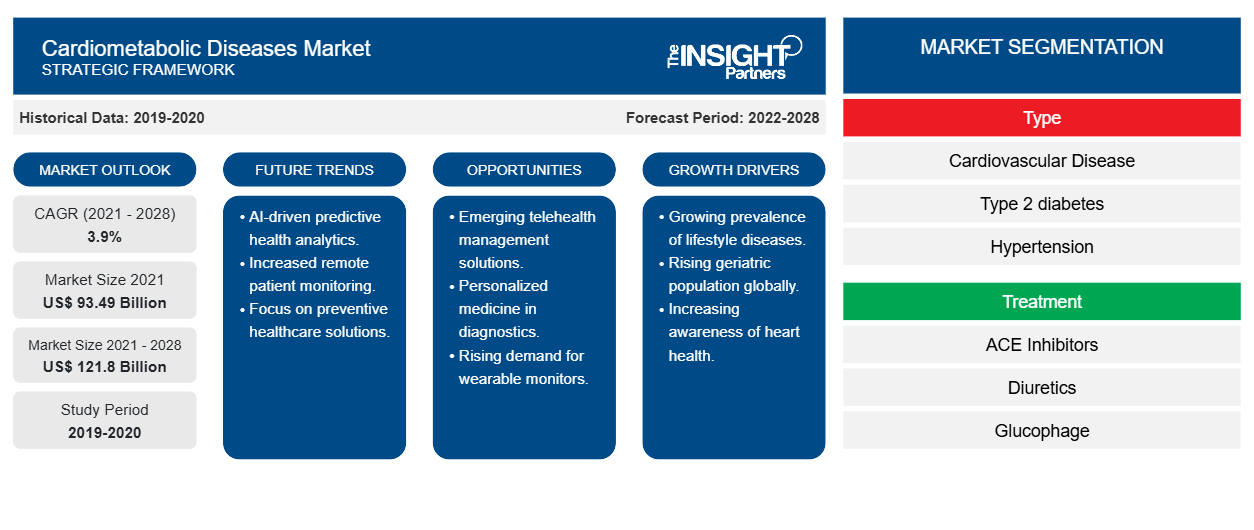Se espera que el mercado de enfermedades cardiometabólicas alcance los US$ 121.804,49 millones para 2028 desde los US$ 93.494,41 millones en 2021; se estima que crecerá a una CAGR del 3,9% durante 2021-2028.
La enfermedad cardiometabólica se caracteriza por un grupo de anomalías y síntomas que aumentan el riesgo de que las personas desarrollen enfermedades cardiovasculares. La hipertensión, la obesidad, la resistencia a la insulina, la dislipidemia, el perfil deficiente de colesterol (LDL) y la tolerancia a la glucosa son algunos de los síntomas de las enfermedades cardiometabólicas. Las personas que padecen síndrome cardiometabólico son propensas a sufrir muchas otras enfermedades potencialmente mortales, como diabetes tipo 2, accidente cerebrovascular, enfermedad de las arterias coronarias (EAC) y enfermedad cardiovascular (ECV). Tanto las condiciones genéticas como las ambientales son responsables del desarrollo de las enfermedades.
El crecimiento del mercado de enfermedades cardiometabólicas se atribuye principalmente a factores como la creciente prevalencia de enfermedades cardiometabólicas y la innovación en la terapéutica de las enfermedades cardiometabólicas. Sin embargo, el infradiagnóstico de las ECV en los países de ingresos bajos y medios (PIBM) está obstaculizando el crecimiento del mercado.
Personalice este informe según sus necesidades
Obtendrá personalización en cualquier informe, sin cargo, incluidas partes de este informe o análisis a nivel de país, paquete de datos de Excel, así como también grandes ofertas y descuentos para empresas emergentes y universidades.
-
Obtenga las principales tendencias clave del mercado de este informe.Esta muestra GRATUITA incluirá análisis de datos, desde tendencias del mercado hasta estimaciones y pronósticos.
Perspectivas de mercado:
aumento de la prevalencia de enfermedades cardiometabólicas
Las enfermedades cardiometabólicas (EMC) son una de las principales causas de muerte en todo el mundo. Estas enfermedades son causadas principalmente por un estilo de vida poco saludable, la inactividad física, el tabaquismo y una dieta poco saludable. Las ECM incluyen enfermedades cardiovasculares (ECV), diabetes mellitus e insuficiencia renal crónica. Según la OMS, alrededor de 17,9 millones de personas murieron por ECV en 2019, lo que representa el 32% de todas las muertes mundiales. De estas muertes, el 85% se debieron a ataques cardíacos y accidentes cerebrovasculares.
La mayoría de las enfermedades cardiovasculares se pueden prevenir abordando factores de riesgo conductuales, como el consumo de tabaco, las opciones alimentarias poco saludables, la obesidad, la inactividad física y el consumo de alcohol. La diabetes es una de las enfermedades crónicas potencialmente mortales que no tiene cura funcional. Provoca diversas complicaciones y aumenta el riesgo general de muerte prematura. El ataque cardíaco, el accidente cerebrovascular, la insuficiencia renal, la amputación de piernas, la pérdida de visión y el daño nervioso son las principales complicaciones asociadas con la diabetes. Según la Federación Internacional de Diabetes (FID), en 2019, aproximadamente 463 millones de adultos vivían con diabetes, y se espera que esta cifra llegue a los 700 millones en 2045.IDF), in 2019, ~463 million adults were living with diabetes, which is expected to reach 700 million by 2045.
Existe un aumento global en el número de personas que padecen una o más enfermedades cardiovasculares debido al aumento del tabaquismo, la falta de ejercicio, el consumo de alcohol y los hábitos alimentarios poco saludables. Según las estadísticas de la OMS de julio de 2021, más de 8 millones de personas mueren cada año debido al consumo de tabaco. Su consumo es mayor en los países de ingresos bajos y medios, donde el 80% de su base mundial de consumidores vive. La creciente prevalencia de la obesidad está dando lugar a que la base de pacientes también sufra enfermedades cardiovasculares. Con este rápido aumento de la prevalencia de las enfermedades cardiometabólicas, la necesidad de tratamientos adecuados para las enfermedades cardiometabólicas se ha disparado, lo que ha dado lugar a un tremendo crecimiento del mercado.CMDs due to increasing smoking, lack of exercise, alcohol consumption, and unhealthy food habits. As per the WHO July 2021 stats, more than 8 million people die every year due to tobacco consumption. Its consumption is higher in low- and middle-income countries, with 80% of its global consumer base living in these countries. The increasing prevalence of obesity is giving rise to the patient base suffering from CMDs as well. With this rapid upswing in the prevalence of CMDs, the need for appropriate cardiometabolic disease treatments has skyrocketed, resulting in tremendous growth of the market.
Perspectivas basadas en tipos
El mercado de enfermedades cardiometabólicas, por tipo, está segmentado en enfermedades cardiovasculares (ECV), hipertensión, diabetes tipo 2 y obesidad. El segmento de enfermedades cardiovasculares (ECV) tuvo la mayor participación del mercado en 2021, y se prevé que registre la CAGR más alta del mercado durante el período de pronóstico.cardiometabolic diseases market, by type, is segmented into cardiovascular disease (CVD), hypertension, type 2 diabetes, and obesity. The cardiovascular disease (CVD) segment held the largest share of the market in 2021, and the segment is anticipated to register the highest CAGR in the market during the forecast period.
Perspectivas basadas en el tratamiento
Por tratamiento, el mercado de enfermedades cardiometabólicas se segmenta en inhibidores de la ECA, diuréticos, Glucophage y otros. El segmento de inhibidores de la ECA tuvo la mayor participación del mercado en 2021, y se prevé que el mismo segmento registre la CAGR más alta del mercado durante el período de pronóstico.cardiometabolic diseases market is segmented into ACE inhibitors, diuretics, Glucophage, and others. The ACE inhibitors segment held the largest share of the market in 2021, and the same segment is anticipated to register the highest CAGR in the market during the forecast period.
Perspectivas basadas en dosis
El mercado de enfermedades cardiometabólicas, por dosis, se divide en comprimidos e inyecciones. El segmento de comprimidos tuvo una mayor participación de mercado en 2021 y se prevé que registre una CAGR más alta en el mercado durante el período de pronóstico.
Información basada en la ruta de administración
El mercado de enfermedades cardiometabólicas, por vía de administración, se divide en oral e intravenosa. En 2021, el segmento oral tuvo una mayor participación en el mercado y se espera que registre una CAGR más alta en los próximos años.
Información basada en los usuarios finales
El mercado de enfermedades cardiometabólicas, por usuarios finales, está segmentado en entornos clínicos, hospitalarios y de atención domiciliaria. En 2021, el segmento hospitalario tuvo la mayor participación del mercado y se prevé que registre la CAGR más alta del mercado durante el período de pronóstico.
Los lanzamientos y aprobaciones de productos son estrategias que las empresas suelen adoptar para ampliar su presencia global y sus carteras de productos. Además, los actores del mercado de pruebas desarrollado en laboratorio se centran en la estrategia de asociación para ampliar su clientela, lo que, a su vez, les permite mantener su marca a nivel mundial.
El informe segmenta el mercado de enfermedades cardiometabólicas de la siguiente manera
Según el tipo, el mercado de enfermedades cardiometabólicas se segmenta en enfermedades cardiovasculares (ECV), hipertensión, diabetes tipo 2 y obesidad. Según el tratamiento, el mercado se segmenta en inhibidores de la ECA, diuréticos, Glucophage y otros. Según la dosis, el mercado de enfermedades cardiometabólicas se bifurca en comprimidos e inyecciones. Según la vía de administración, el mercado se bifurca en oral e intravenosa. Según los usuarios finales, el mercado de enfermedades cardiometabólicas se segmenta en entornos clínicos, hospitalarios y de atención domiciliaria. Por geografía, el mercado está segmentado en América del Norte (EE. UU., Canadá y México), Europa (Reino Unido, Alemania, Francia, Italia, España y el resto de Europa), Asia Pacífico (China, Japón, India, Australia, Corea del Sur y el resto de Asia Pacífico), Oriente Medio y África (EAU, Arabia Saudita, Sudáfrica y el resto de Oriente Medio y África) y América del Sur y Central (Brasil, Argentina y el resto de América del Sur y Central).
Perspectivas regionales del mercado de enfermedades cardiometabólicas
Los analistas de Insight Partners explicaron en detalle las tendencias y los factores regionales que influyen en el mercado de enfermedades cardiometabólicas durante el período de pronóstico. Esta sección también analiza los segmentos y la geografía del mercado de enfermedades cardiometabólicas en América del Norte, Europa, Asia Pacífico, Oriente Medio y África, y América del Sur y Central.

- Obtenga datos regionales específicos para el mercado de enfermedades cardiometabólicas
Alcance del informe de mercado sobre enfermedades cardiometabólicas
| Atributo del informe | Detalles |
|---|---|
| Tamaño del mercado en 2021 | US$ 93,49 mil millones |
| Tamaño del mercado en 2028 | US$ 121.8 mil millones |
| CAGR global (2021-2028) | 3,9% |
| Datos históricos | 2019-2020 |
| Período de pronóstico | 2022-2028 |
| Segmentos cubiertos |
Por tipo
|
| Regiones y países cubiertos |
América del norte
|
| Líderes del mercado y perfiles de empresas clave |
|
Densidad de actores del mercado: comprensión de su impacto en la dinámica empresarial
El mercado de enfermedades cardiometabólicas está creciendo rápidamente, impulsado por la creciente demanda de los usuarios finales debido a factores como la evolución de las preferencias de los consumidores, los avances tecnológicos y una mayor conciencia de los beneficios del producto. A medida que aumenta la demanda, las empresas amplían sus ofertas, innovan para satisfacer las necesidades de los consumidores y aprovechan las tendencias emergentes, lo que impulsa aún más el crecimiento del mercado.
La densidad de actores del mercado se refiere a la distribución de las empresas o firmas que operan dentro de un mercado o industria en particular. Indica cuántos competidores (actores del mercado) están presentes en un espacio de mercado determinado en relación con su tamaño o valor total de mercado.
Las principales empresas que operan en el mercado de enfermedades cardiometabólicas son:
- Eli Lilly y compañía
- Bayer AG
- Productos farmacéuticos Arrowhead, Inc.
- Novartis AG
- Boehringer Ingelheim International GmbH
Descargo de responsabilidad : Las empresas enumeradas anteriormente no están clasificadas en ningún orden particular.

- Obtenga una descripción general de los principales actores clave del mercado de enfermedades cardiometabólicas
Perfiles de empresas
- Eli Lilly y compañía
- Bayer AG
- Productos farmacéuticos Arrowhead, Inc.
- Novartis AG
- Boehringer Ingelheim International GmbH
- Novo Nordisk A/S
- AstraZeneca
- Productos farmacéuticos Alnylam, Inc.
- Cardax, Inc
- Compañía Kowa, Ltd.
- Análisis histórico (2 años), año base, pronóstico (7 años) con CAGR
- Análisis PEST y FODA
- Tamaño del mercado, valor/volumen: global, regional y nacional
- Industria y panorama competitivo
- Conjunto de datos de Excel
Informes recientes
Testimonios
Razón para comprar
- Toma de decisiones informada
- Comprensión de la dinámica del mercado
- Análisis competitivo
- Información sobre clientes
- Pronósticos del mercado
- Mitigación de riesgos
- Planificación estratégica
- Justificación de la inversión
- Identificación de mercados emergentes
- Mejora de las estrategias de marketing
- Impulso de la eficiencia operativa
- Alineación con las tendencias regulatorias























 Obtenga una muestra gratuita para - Mercado de enfermedades cardiometabólicas
Obtenga una muestra gratuita para - Mercado de enfermedades cardiometabólicas